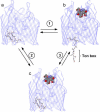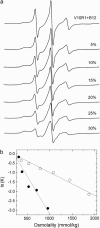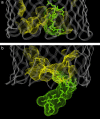Solutes modify a conformational transition in a membrane transport protein
- PMID: 16443663
- PMCID: PMC1414566
- DOI: 10.1529/biophysj.105.078246
Solutes modify a conformational transition in a membrane transport protein
Abstract
The bacterial outer-membrane vitamin B(12) transporter, BtuB, undergoes a dramatic order-to-disorder transition in its N-terminal energy-coupling motif (Ton box) upon substrate binding. Here, site-directed spin labeling (SDSL) is used to show that a range of solutes prevents this conformational change when ligand is bound to BtuB, resulting in a more ordered Ton box structure. For each solute examined, the data indicate that solutes effectively block this conformational transition through an osmotic mechanism. The molecular weight dependence of this solute effect has been examined for a series of polyethylene glycols, and a sharp molecular weight cutoff is observed. This cutoff indicates that solutes are preferentially excluded from a cavity within the protein as well as the protein surface. Furthermore, the sensitivity of the conformational change to solution osmolality is consistent with a structural model predicted by SDSL. When the Ton box is unfolded by detergents or mutations (rather than by ligand binding), solutes, such as polyethylene glycols and salts, also induce a more structured compacted conformation. These results suggest that conformational changes in this class of outer membrane transporters, which involve modest energy differences and changes in hydration, may be modulated by a range of solutes, including solutes typically used in protein crystallization.
Figures






Similar articles
-
Identifying and quantitating conformational exchange in membrane proteins using site-directed spin labeling.Acc Chem Res. 2014 Oct 21;47(10):3102-9. doi: 10.1021/ar500228s. Epub 2014 Aug 25. Acc Chem Res. 2014. PMID: 25152957 Free PMC article. Review.
-
Spectroscopic evidence that osmolytes used in crystallization buffers inhibit a conformation change in a membrane protein.Biochemistry. 2003 Nov 18;42(45):13106-12. doi: 10.1021/bi035439t. Biochemistry. 2003. PMID: 14609320
-
Substrate-induced conformational changes of the periplasmic N-terminus of an outer-membrane transporter by site-directed spin labeling.Biochemistry. 2003 Feb 18;42(6):1391-400. doi: 10.1021/bi027120z. Biochemistry. 2003. PMID: 12578351
-
Substrate-dependent unfolding of the energy coupling motif of a membrane transport protein determined by double electron-electron resonance.Biochemistry. 2006 Sep 12;45(36):10847-54. doi: 10.1021/bi061051x. Biochemistry. 2006. PMID: 16953570 Free PMC article.
-
Molecular mechanism of ferricsiderophore passage through the outer membrane receptor proteins of Escherichia coli.Biometals. 2007 Jun;20(3-4):263-74. doi: 10.1007/s10534-006-9060-9. Epub 2006 Dec 22. Biometals. 2007. PMID: 17186377 Review.
Cited by
-
Conformational exchange in a membrane transport protein is altered in protein crystals.Biophys J. 2010 Sep 8;99(5):1604-10. doi: 10.1016/j.bpj.2010.06.026. Biophys J. 2010. PMID: 20816073 Free PMC article.
-
Inter-spin distance determination using L-band (1-2 GHz) non-adiabatic rapid sweep electron paramagnetic resonance (NARS EPR).J Magn Reson. 2012 Aug;221:51-6. doi: 10.1016/j.jmr.2012.05.006. Epub 2012 May 15. J Magn Reson. 2012. PMID: 22750251 Free PMC article.
-
Simple Selection Procedure to Distinguish between Static and Flexible Loops.Int J Mol Sci. 2020 Mar 26;21(7):2293. doi: 10.3390/ijms21072293. Int J Mol Sci. 2020. PMID: 32225102 Free PMC article.
-
Identifying and quantitating conformational exchange in membrane proteins using site-directed spin labeling.Acc Chem Res. 2014 Oct 21;47(10):3102-9. doi: 10.1021/ar500228s. Epub 2014 Aug 25. Acc Chem Res. 2014. PMID: 25152957 Free PMC article. Review.
-
Spin labeling and Double Electron-Electron Resonance (DEER) to Deconstruct Conformational Ensembles of HIV Protease.Methods Enzymol. 2015;564:153-87. doi: 10.1016/bs.mie.2015.07.019. Epub 2015 Sep 1. Methods Enzymol. 2015. PMID: 26477251 Free PMC article.
References
-
- Faraldo-Gómez, J. D., and M. S. P. Sansom. 2003. Acquisition of siderophores in gram-negative bacteria. Nat. Rev. Mol. Cell Biol. 4:105–116. - PubMed
-
- Postle, K., and R. Kadner. 2003. Touch and go: tying TonB to transport. Mol. Microbiol. 49:869–882. - PubMed
-
- Fanucci, G. E., K. A. Coggshall, N. Cadieux, M. Kim, R. J. Kadner, and D. S. Cafiso. 2003. Substrate-induced conformational changes of the periplasmic N-terminus of an outer-membrane transporter by site-directed spin labeling. Biochemistry. 42:1391–1400. - PubMed
Publication types
MeSH terms
Substances
Grants and funding
LinkOut - more resources
Full Text Sources

